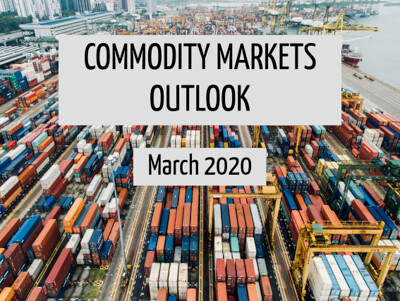
Global Macro/Metals: The full economic impact of lockdowns will depend on the duration of imposed measures and the pace at which these measures will be relaxed. For countries impacted, optimistic estimations of 6% to 10% yearly GDP reduction for 2020 are pricing in the benefit of fiscal policies and dovish monetary policies that will help the rebound that could be seen in Q3. COVID-19 testing is quickly becoming the key element to accelerate the rebound. In locked-down countries, consumer spending (like auto sales), except for ecommerce, has basically stopped and industrial production has been reduced in many areas. Company earnings don’t seem to be fully priced in yet (only the most pessimistic analysts are estimating a 30% drop of S&P 500 EPS for 2020). Industrial metals demand is expected to be reduced by about 5% (a huge number compared to the historical change of demand which usually varies less than 1%), the lack of price impact (our reference base metal basket is only down 8% on the month) demonstrates that prices are already close to or at the marginal cost of production. Base metals usage is evenly split between manufacturing and infrastructure/construction, with the latter being less impacted on average. Supply disruption has also occurred on certain metals (zinc and nickel) but is not expected to remain. Gold has seen an increase of volatility with some sharp intraday moves but has not yet been seen as the currency of last resort. The run for cash has triggered more redemptions in gold funds than subscriptions. Short term deflationary pressures are also not helping gold’s fundamental hedge against inflation, but gold rallied during the last stage of the 2008 crisis. Liquid real assets benefit when paper currency loses in value. Palladium underwent huge volatility. The price dropped by half (50%) due to expected demand drop in a thin market, and recovered almost all its loss due to supply disruptions in mines in Africa (-7% on the month). Platinum recovered less as the market started from a fundamental weaker situation (-15% on the month and -25% on the year).
Energy: The unprecedented collapse of oil demand (estimated at 26 Mio b/d which may be exaggerated) over the last few weeks has led to a de-facto break of OPEC as we know it. The fragile accord on which OPEC countries were benefiting relatively less than non-OPEC producers from self-imposed production cuts has led to an increase in production at the worst possible time. As all producers are suffering low prices, a consorted reduction of production is likely to occur. Whether it will be followed by the lowest cost producers is questionable. Elasticity of supply in petroleum is slow and expensive, particularly for the highest cost producers. Shale wells are high cost but can have a relatively fast response. However, they may not do so as they are usually hedged 1 year forward. Storage capacity was important at the start of the crisis and it will take time to fill up all storages even if the rate is very high. Any agreement to cut production up to 10 Mio b/d will ‘buy time’ for storage capacity onshore, although the politicisation of the market is increasing unforeseen volatility drastically. Floating storage has been inhibited for now due to the high cost of freight as Saudi Arabia increased production. Within the transportation sector (which accounts for about 50% of oil usage globally), airlines and gasoline usage will be cut the most. US implied demand for gasoline (from inventory build) as per last week has dropped 3 Mio b/d. The spread has moved in sharp contango and is likely to remain as fundamental ‘catch-up’ with the pricing as we start seeing saturation of storage in April.
Agriculture: On the grain complex, demand is higher than usual as people around the globe are stocking food. We see demand for soybean, corn and wheat increasing from a consumer side (wheat is up 7% on the month). There are also concerns about limitation of exports (Russia limited its wheat exports) and some countries have been increasing their reserves (China imported 5 times more Soybean in the first 2 months of the year than last year). Corn demand for ethanol dropped, representing most of the volatility of the demand (corn was down 7% on the month).
Volatility: Most asset classes showed spikes of volatility around the middle of the month not seen since the GFC. Once again the highest volatility levels remain in the energy sector, impacted simultaneously by the Coronavirus and the Saudi-Russian price war. Crude oil implied vol for ATM calls is up on the month from 53% to a staggering 165%. In the equity sector, the VIX is up from 40.11% to 53.54% while the VSTOXX is up from 42.23% to 48.59%. Both equity volatility indices peaked around the mid 80’s throughout the month, which corresponds roughly to their peaks during the GFC. This was in line with the realised volatility over the period, where we witnessed a series of circuit breakers activated for the S&P 500 futures. Both limit-ups and limit-downs were triggered, and during both regular and pre-open trading hours. We have also witnessed gains in volatility in the precious metal complex, most notably in silver, with its implied volatility up from 19% to 42% with peaks to 83%. The spike was more mitigated for gold, with implied volatility up from 20% to 24% on the month with a peak at 55%. In the agricultural sector, implied volatility of corn was up from 17% to 23% with a spike at 33%, for soybean it was up from 14% to 16% with a peak at 25%.
Source: Four Elements Capital

